For those budding oncologists out there
A 3-year-old male with acute lymphoblastic leukemia undergoing induction chemotherapy developed some discrete, painful lesions on his arms and legs about 16 days into his therapy. He also is having the predictable problems related to chemotherapy such as nausea, vomiting and diarrhea (which was recently associated with Clostridium difficile). However, he has had no fever so far. He is currently receiving a combination of vincristine, dexamethasone and metronidazole (for the C. difficile) and has been neutropenic for more than 1 week.

James H. Brien
His past medical history was that of a healthy child until the diagnosis of leukemia. There has been no travel, animal exposure, insect bites or injuries, and his immunizations are up to date.
Examination revealed normal vital signs and no distress. The exam was otherwise positive, only for several discrete, painful, erythematous papular lesions on his extremities and one more recent lesion on his abdomen. Some of the older lesions were larger with surrounding edema and changing to a darker color (Figures 1–3). Lab tests revealed the following: An absolute neutrophil count (ANC) of 800 (but had been lower), a positive 1-3-beta-D-glucan, a negative Aspergillus galactomannan, and a negative blood culture (including fungal). A biopsy of a typical lesion is shown (Figure 4).
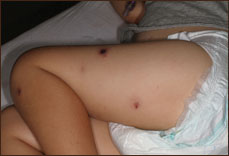
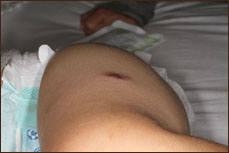
Some of the older lesions were larger with surrounding edema and changing to a darker color (Figures 1–3).
Source:Brien JH
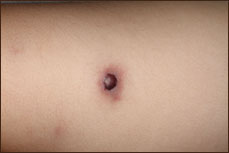
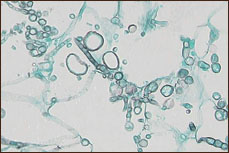
Some of the older lesions were larger with surrounding edema and changing to a darker color (Figure 3). A biopsy of a typical lesion is shown (Figure 4).
Case Discussion
This would be a question that might appear on the infectious diseases or hematology/oncology board exam. This turned out to be fusariosis (B); an infection with a Fusarium species, almost exclusively seen in immunocompromised patients, especially neutropenic cancer patients. It’s surprising that we don’t see it more often, given how ubiquitous the organism is in the environment, especially the soil. The patient becomes colonized in the respiratory tract and/or gut and under certain stressful circumstances, which may include prolonged periods of neutropenia; it may breech the mucous membrane barrier and travel through the bloodstream to other sites.
In this case, septic emboli result in these focal cutaneous infections. The fungus has angioinvasive properties, interfering with the microcirculation that soon leads to lesions becoming necrotic, with characteristic dark or black overlying skin, as shown. The biopsy reveals septate hyphae with characteristic “ballooning” (Figure 4). On high power, one can see a vascular structure packed with fungal elements (Figure 5). Diagnosis can be confirmed by PCR or culture. Serum markers that may help support the diagnosis when waiting for a positive culture include a 1-3-beta-D-glucan, which is a polysaccharide component in the cell wall of most invasive fungi. If detected, it is supportive of a fungal infection. The serum Aspergillus galactomannan test detects this molecule, which is found in the cell wall of Aspergillus. Therefore, when it is negative and the 1-3-beta-D-glucan is positive, the likely pathogen would statistically be Fusarium. This is important, since Aspergillus can produce similar findings. However, the treatment of choice for both is voriconazole, as well as correction of the underlying problem (in this case, neutropenia), if possible.
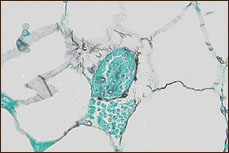
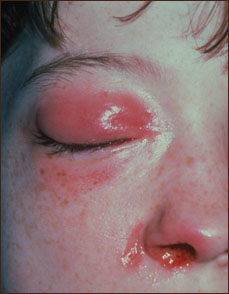
On high power, one can see a vascular structure packed with fungal elements (Figure 5). Zygomycosis similarly has angioinvasive properties but tends to favor infection of the respiratory sinuses of poorly controlled diabetics, resulting in necrosis of the soft tissues involved (Figure 6, courtesy of Basil Williams, DO).
Zygomycosis similarly has angioinvasive properties but tends to favor infection of the respiratory sinuses of poorly controlled diabetics, resulting in necrosis of the soft tissues involved (Figure 6, courtesy of Basil Williams, DO), with potential for intracranial spread, which is often referred to as rhinocerebral zygomycosis, or historically, mucormycosis. Treatment is multifactorial; prompt surgical debridement, correction of ketoacidosis if diabetic or neutropenia if cancer, and high-dose amphotericin B, the drug of choice.
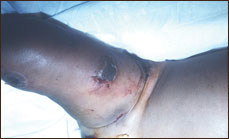
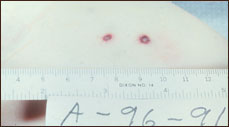
Lesions also begin as inflammatory papules that progress to necrosis, if the patient lives long enough to go through these necrotic changes (Figure 7). The lesion will appear to be inflamed rather than necrotic as seen in Figure 8, from the autopsy of a rapidly fatal case of Pseudomonas sepsis.
Ecthyma gangrenosum also is seen in the immune-compromised, neutropenic patients and possibly in burn patients and classically caused by Pseudomonas aeruginosa sepsis. Lesions also begin as inflammatory papules that progress to necrosis, if the patient lives long enough to go through these necrotic changes (Figure 7). If the patient dies early in the course of the infection, the lesion will appear to be inflamed rather than necrotic (Figure 8, from the autopsy of a rapidly fatal case of Pseudomonas sepsis). Ecthyma gangrenosum should be treated with aggressive antipseudomonas antimicrobial therapy.
I know that my comments have been relegated to the History of Medicine blog, but I simply want to acknowledge my sadness upon learning of the death of my friend Mike Marcy, MD, one of the brightest and most collegial people I have ever met. Every time we were together, I laughed and learned a lot. His long and distinguished career is nicely summarized in the Sept. 14 Los Angeles Times obituary website. If you are looking to be humbled and inspired at the same time, I would recommend reading it.
For more information:
James H. Brien, DO, is with the department of infectious diseases at McLane Children’s Hospital, Baylor Scott & White Health, Texas A&M College of Medicine in Temple, Texas. He is also a member of the Infectious Diseases in Children Editorial Board. Brien can be reached at: jhbrien@aol.com.
Disclosure: Brien reports no relevant financial disclosures.
